
You know organizations that encourage a feedback culture are 24% more likely to experience high innovation.
And that’s exactly why employee feedback is not to be taken lightly. It is a direct, efficient tool that will propel your workplace to greater heights, enhancing employee experience.
And trust me, it isn’t just about fixing what’s broken, it’s about fostering a culture that’s inclusive, and downright awesome. And for that, all you need is an efficient employee feedback tool at your disposal.
So, let’s find out more about employee feedback, its different types, and the employee feedback surveys that make all this much smoother!
But let’s first start with understanding what employee feedback is and why it matters.
Understanding Employee Feedback
What is Employee Feedback?
Employee feedback refers to the process of providing and receiving information about an employee’s performance, behavior, or contributions in the workplace. It is a two-way communication where employers share insights with employees, and employees, in turn, offer their perspectives. The goal is to enhance performance, foster professional growth, and contribute to the overall improvement of the work environment.
But, Why Does Employee Feedback Matter?
A study by ZengerFolkman found that organizations promoting feedback-rich cultures are 8.9 times more likely to have effective and efficient employees.
This just shows that you just CANNOT ignore the value of employee feedback!
Here are some more reasons behind the importance of employee feedback:
- Enhances Communication: Providing a platform for employee feedback fosters an environment of open and transparent communication within the team. It’s like opening the windows to let in fresh air – ideas flow more freely, and everyone feels more connected.
- Empowers Employees: When employees know that their opinions matter, it’s like handing them a microphone. They feel valued and heard, which is a powerful motivator. This empowerment not only boosts morale but also encourages individuals to actively contribute to the team’s success.
- Promotes Continuous Improvement: Feedback serves as a compass for improvement. By pinpointing areas that need attention, it becomes a catalyst for growth and development. It’s not just about fixing what’s broken; it’s about evolving and getting better continuously. Employee feedback is the roadmap for this journey of improvement.
- Strengthens Team Dynamics: Teams are like ecosystems, and feedback is the nutrient that helps them thrive. Constructive feedback fosters a culture of collaboration and mutual respect. It’s about recognizing each other’s strengths and addressing areas of improvement collectively, creating a harmonious and effective team dynamic.
- Aligns with Organizational Goals: Employee feedback acts as a bridge between individual experiences and organizational objectives. When employees understand how their contributions fit into the bigger picture, it creates alignment with company goals. It’s not just about doing tasks; it’s about understanding the purpose and impact of those tasks on the broader organizational vision.
In essence, employee feedback is not just a box to check; it’s an imperative that fuels communication, empowerment, improvement, team dynamics, and organizational alignment. It’s what keeps the digital workplace engaging, interesting and thriving!
Now that you’ve witnessed how employee feedback increases engagement and strengthens your company, why wait? Launch employee feedback surveys right away!
Let’s now know more about the different varieties of employee feedback that can take your employee experience to the next level!
Types of Employee Feedback

In the dynamic realm of professional growth and development, various types of feedback play distinct roles in shaping individuals, teams, and organizations.
So, here are 6 types of Employee Feedback that can help you boost your employee experience:
- Performance Feedback: Performance feedback is used to provide employees with feedback on their work performance in an effort to increase engagement and productivity. It is an integrated, strategic approach that involves planning, check-in, and review.
For example –
- How effectively did you meet your performance goals during the evaluation period?
- Can you provide specific examples of achievements or challenges you encountered in your role?
- Constructive Feedback: Constructive feedback provides both positive and critical comments to help someone improve their work, offering clear reasoning and observations to support suggestions for progress.
For example –
- What specific areas do you think you could improve upon to enhance your performance?
- How can we support you better in achieving your goals and overcoming challenges?
- Appreciative and Positive Feedback: Positive feedback highlights an employee’s strengths and contributions to the company’s success, making them feel valued and motivated to continue making valuable contributions, leading to increased dedication.
For example-
- What accomplishments are you most proud of since our last feedback session?
- Can you share any instances where your contributions positively impacted the team or organization?
- 360-Degree Feedback: 360 Degree Feedback is a performance evaluation method where feedback is collected from various sources, including supervisors, peers, subordinates, and sometimes even customers or clients, providing a comprehensive view of an individual’s strengths and areas for improvement.
For example-
- How would you rate your communication skills as perceived by your peers, supervisors, and subordinates?
- What areas do you believe you excel in, according to feedback from different stakeholders?
- Annual or Periodic Reviews: Annual or periodic reviews are given to employees on a yearly or scheduled basis. These assessments help individuals to reflect on their accomplishments, receive feedback, and collaboratively set goals for the future.
For example-
- Reflecting on the past year/evaluation period, what achievements are you most proud of?
- What are your goals and objectives for the upcoming year/evaluation period?
- Anonymous Feedback: By providing employees with the option to share their thoughts and opinions without revealing their identity, this approach cultivates an environment where individuals feel more comfortable expressing candid feedback. It serves as a powerful tool for uncovering genuine concerns, innovative ideas, and constructive criticism that might otherwise remain unspoken.
For example-
- What aspects of our team or organization do you think are working well, and what could be improved?
- Is there anything you’d like to share anonymously that you feel may benefit the team or organization?
- Team Feedback: Team feedback involves gathering insights from team members to evaluate various aspects of teamwork, collaboration, and communication. This collaborative approach provides a view of the team dynamics, enabling an in-depth understanding of how individuals interact and contribute to collective goals.
For example-
- How would you rate the level of collaboration and teamwork within our team?
- Are there any areas where you feel our team could improve its communication or effectiveness?
- Managerial Feedback: Managerial feedback is provided to managers about their performance, leadership, and managerial skills, often coming from their superiors, peers, or subordinates, aimed at helping them improve their effectiveness in leading teams and achieving organizational goals.
For example-
- How satisfied are you with the feedback and support you receive from your manager?
- Are there any specific areas where you’d like more guidance or coaching from your manager?
The Four Pillars of Effective Feedback
Imagine a tech company where a team of developers is working on a critical project with tight deadlines. The team has been grappling with challenges, and the project is at risk of falling behind schedule. The manager, recognizing the importance of effective feedback, decides to conduct a feedback session. During the session, team members express their concerns about the complexity of certain tasks and the need for additional resources. They implement changes based on the insights gathered.
As a result of this feedback-driven intervention, the team experiences a significant boost in morale and productivity.
Doesn’t that sound wonderful?
Now, every organization needs a robust understanding of employee feedback and its implementation to have an impact on their employee experience as well as their company’s work culture and productivity.
So here are the 4 pillars that can help you create an effective employee feedback mechanism for your organization:
1. Creating a Safe and Open Environment
According to a study by Harvard Business Review, employees in safe environments are more likely to share innovative ideas and take risks that can lead to groundbreaking solutions.
This means fostering an atmosphere where employees feel secure and confident in expressing their opinions, ideas, and concerns without fear of reprisal or negative consequences. When employees feel safe, they are more likely to provide honest and constructive feedback. This is crucial for identifying areas of improvement and innovation within the organization.
How to achieve this:
- Establish a culture of trust by leading with transparency.
- Foster open communication through regular team check-ins.
- Address fears head-on, emphasizing the growth potential in feedback.
- Acknowledge and reward employee contributions.
2. Providing Regular and Timely Feedback
Move beyond the annual surveys and start gathering feedback regularly. Because only when you gather consistently and after short intervals, can your teams adapt fast to changing goals and priorities. Plus, all that feedback helps build a culture of constant improvement, which means happier and more engaged employees overall.
And the Harvard Business Review study says the same – Companies giving regular feedback see a whopping 3.6 times more engaged employees than those who don’t.
How to achieve this:
- Embrace the versatility of various feedback surveys such as 360-degree and pulse surveys.
- Communicate the importance of this regular feedback amongst the employees and the reason behind it.
- Automate the process with a robust employee feedback tool.
3. Focusing on Specific and Actionable Feedback
Vague feedback lacks detail and clarity, making it difficult to understand or act upon, while specific feedback provides clear guidance for improvement.
For instance, if I tell you “Good job,” it doesn’t really tell you if there is anything you could improve. On the other hand feedback like “Your presentation was engaging, but consider slowing down for clarity” tells you exactly what you need to improve!
That’s why I say avoid generalizations and focus on distinct aspects of performance. It is constructive and guides steps the recipient can take to improve their performance.
And get this – A Harvard Business Review study found that 72% of employees who receive specific feedback are more likely to achieve their objectives.
How to achieve this:
- Illuminate the difference between vague and specific feedback.
- Provide shining examples of actionable feedback that sparks improvement.
- Encourage a culture where constructive feedback hones in on actions.
- Help your team see the broader impact of their work.
4. Actively Listening and Encouraging Dialogue
Deloitte says organizations with a culture of open communication are 3.5 times more likely to be innovative and agile.
But open communication isn’t about talking, but about listening. And active listening goes beyond just hearing words. Because when individuals feel heard, they are more likely to be invested in their work and the overall success of the organization.
How to achieve this:
- Cultivate active listening skills for a receptive feedback atmosphere.
- Inspire dialogue by encouraging questions and genuine curiosity.
- Transform feedback sessions into collaborative exchanges, enriching both the giver and receiver.
Are your employees unsure about sharing their identity? Worry not! Create anonymous employee feedback surveys with SurveySensum!
Now, let’s delve into the various types of Employee Feedback Surveys.
Types of Employee Feedback Survey
Employee feedback surveys are crucial tools for gauging employee satisfaction, engagement, and overall sentiment within an organization. There are various types of employee feedback surveys, each serving different purposes.
Wondering which one does what job and how it can help you to boost your organization’s work culture?
Well, let’s discuss all the types of employee feedback surveys along with their examples:
1. Employee Engagement Surveys
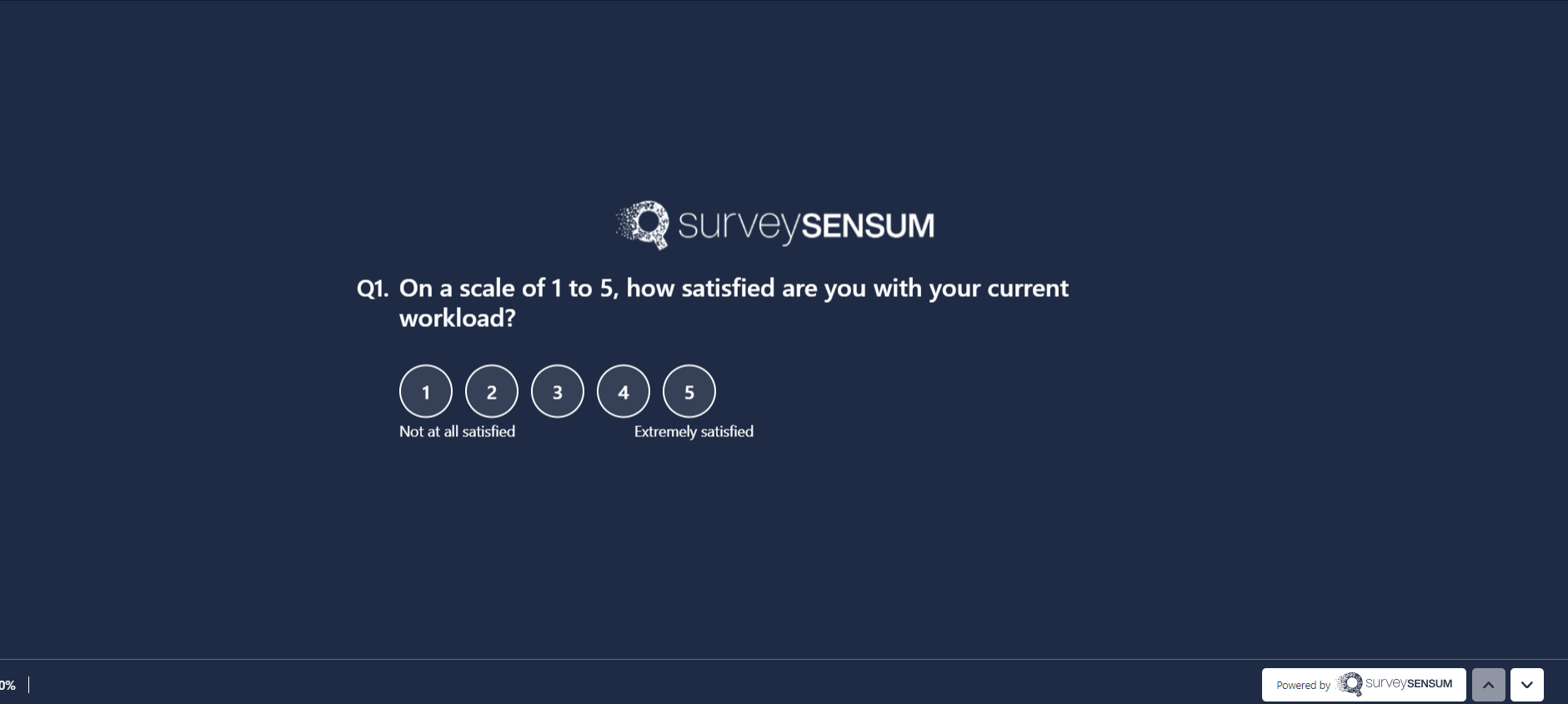
Employee Engagement Platform assess and quantify the degree of employee engagement. The surveys are designed to comprehensively evaluate various facets, including but not limited to job satisfaction, motivation, and loyalty.
Example Questions:
- Do you feel your work is valued by your supervisor?
- How motivated are you to go above and beyond in your role?
- How likely are you to remain with [Company Name] for the next two years?
2. Performance Feedback Surveys
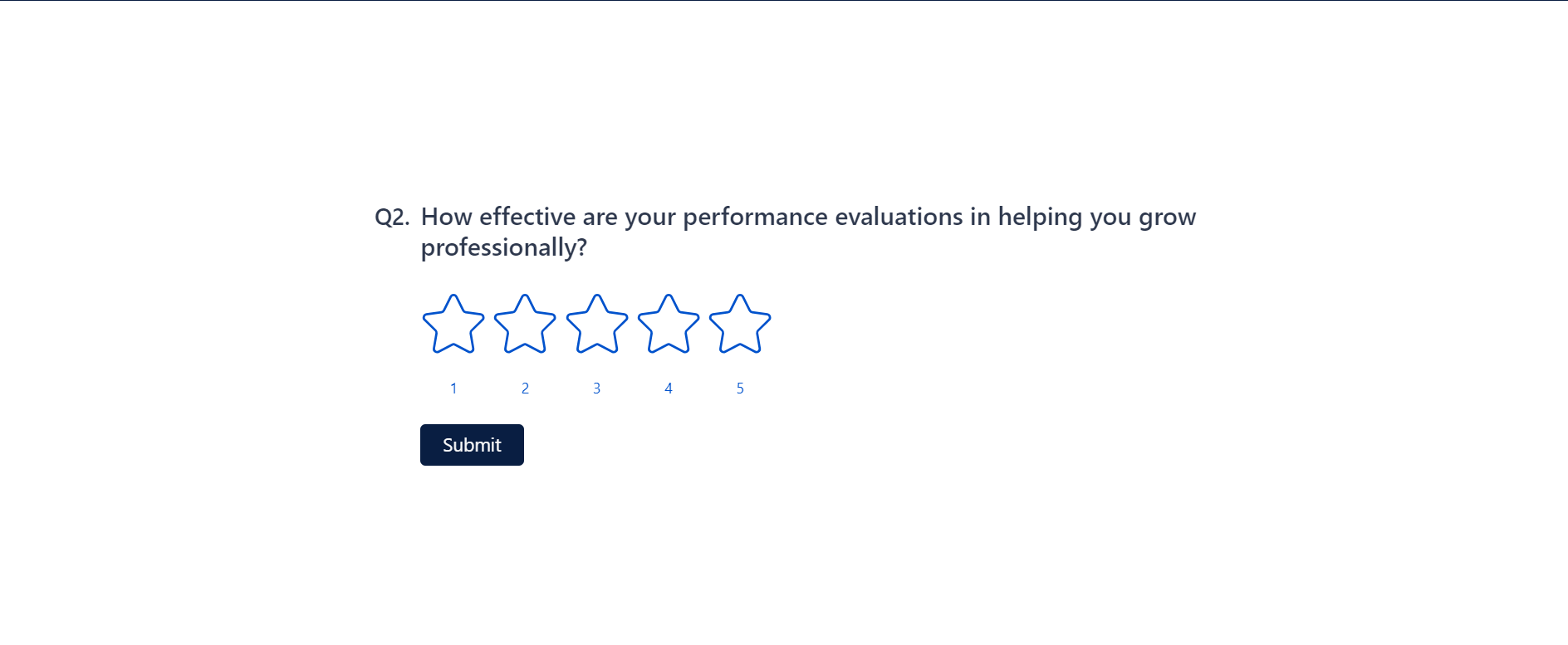
These surveys assess an employee’s performance in several areas, such as job knowledge, communication skills, productivity, student productivity, and the quality of their work. Performance evaluation surveys are typically conducted regularly, such as semi-annually or annually.
Example Questions:
- Do you receive enough feedback on your performance?
- How effective are your performance evaluations in helping you grow professionally?
3. Exit Surveys
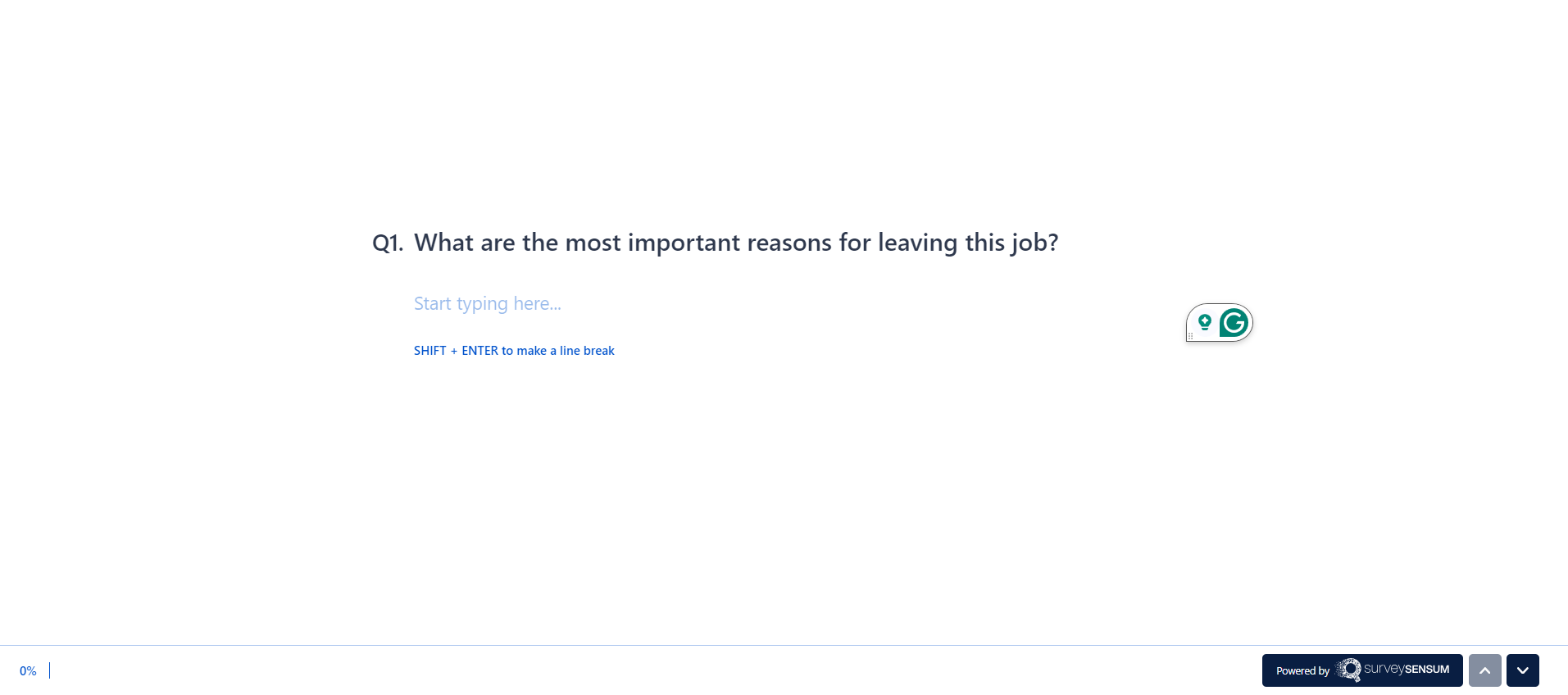
Why did your employee leave the organization?
Well, that’s where employee exit surveys come in. They help you understand the reasons surrounding employee departures from an organization. They are conducted when employees decide to part ways with the company, offering a structured platform to collect detailed feedback regarding the reasons for their departure, their overall experience during their tenure, and areas where the organization could potentially improve.
Example Questions:
- What prompted your decision to leave [Company Name]?
- Do you feel your contributions were adequately recognized during your time here?
4. Onboarding Surveys
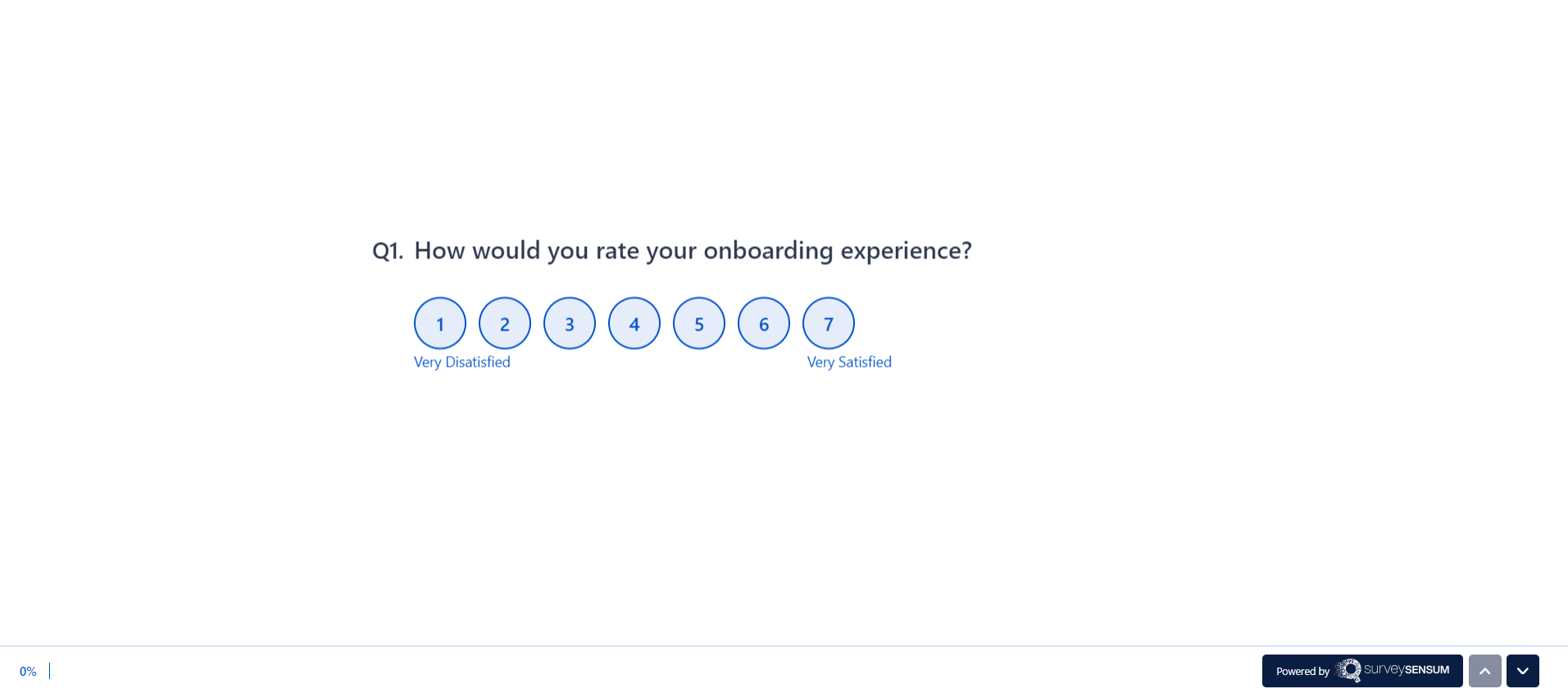
Employee onboarding surveys play a pivotal role in the continuous improvement of an organization’s onboarding process by offering valuable insights into the initial experiences of newly hired employees. Administered during the crucial early days of employment, these surveys aim to capture feedback on various facets of the onboarding journey.
Example Questions:
- How effective was the onboarding process in helping you understand your role and responsibilities?
- Did you receive sufficient information about company policies and procedures during onboarding?
5. 360-Degree Feedback Surveys
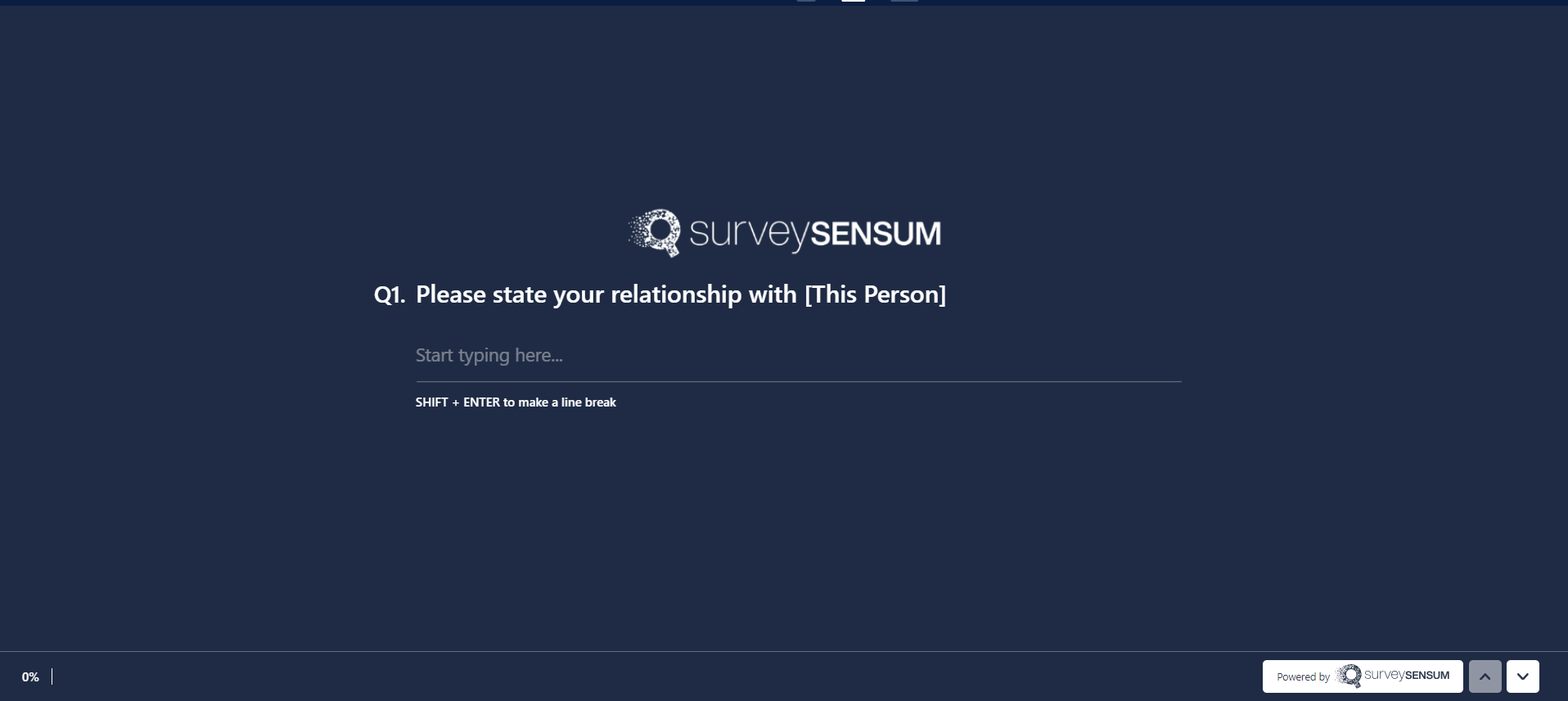
360-degree feedback surveys help collect feedback about a worker’s performance from peers, bosses, and self-evaluations. If an employee engages with the public, input from clients, vendors, contractors, or suppliers can also be included in a 360-degree survey.
Example Questions:
- How would you rate your colleagues’ ability to communicate and collaborate effectively?
- Do you feel supported by your peers in achieving your work goals?
6. Pulse Surveys

Pulse surveys are designed to be shorter and more frequent, and gauge employee sentiments on various aspects of the workplace environment. These surveys act as brief yet powerful tools, offering organizations a pulse check on critical factors such as employee morale, satisfaction levels, and immediate concerns.
Example Questions:
- How satisfied are you with your workload this week?
- Do you feel adequately supported by your immediate team members?
It’s established that employee feedback surveys can take your employee experience to a new level – boosting engagement and satisfaction which directly impacts the business revenue. So it’s time to start gauging your employee feedback
Putting it into Practice
So, you’ve decided to dive into the world of employee feedback – fantastic choice!
However, implementing employee feedback effectively requires a thoughtful approach that considers feedback frameworks, the right tools, training, and the right strategy for navigating difficult conversations. But how do you turn this intention into a reality?
Here’s a breakdown of best practices for each aspect:
Feedback Frameworks and Methodologies
Constructing effective feedback frameworks and methodologies for employee feedback is fundamental in nurturing a workplace culture of continual improvement and employee engagement. These frameworks gather, analyze, and act upon feedback, ensuring a comprehensive understanding of employee sentiments.
Here are the ways in which you can implement these in your workplace:
- Define Clear Objectives: Before you start collecting feedback, figure out where you want to go. Whether it’s boosting engagement, pinpointing growth areas, or sizing up leadership, having set specific goals will become your strength.
- Choose the Right Feedback Method: Depending on your goals and company culture, you might go for annual surveys, pulse surveys (quick check-ins), 360-degree feedback (from all angles), or one-on-one chats.
- Encourage Continuous Feedback: Make feedback a habit, not just a special task. Create a culture where feedback isn’t confined to formal meetings but flows naturally. Giving everyone a chance to share thoughts with colleagues and bosses and heighten your employee experience!
Remember, it’s not just about the feedback – it’s about weaving it into your workplace’s DNA.
Technology Platforms and Resources
Alright, let’s talk about leveling up your feedback game. When it comes to technology platforms, here’s what you should do:
Select a robust employee feedback platform. Invest in a user-friendly platform that turns the feedback journey into a breeze.
Look out for features like anonymous feedback options, customizable survey templates, closed-loop automation, and real-time reporting.
And the best part is if it comes with an end-to-end consultation!
Training and Workshops for Managers and Employees
To make the best of your employee feedback journey, your managers and employees should know how to accurately go about the process. And for that make sure to:
- Provide Training on Giving and Receiving Feedback: Equip your managers and employees with the skills they need to be feedback champions. Teach them the art of constructive feedback, active listening, and the strategies for navigating tricky conversations.
- Promote a Growth Mindset: Create a culture where feedback isn’t a critique but a step in the direction of success. Encourage a mindset that sees feedback as a pathway to learning and growth, both for the employees and the company. Fostering a growth mindset can significantly enhance how feedback is received and utilized within the organization, promoting continuous improvement and resilience.
- Offer Coaching and Support: Provide ongoing coaching and resources to guide your team through the feedback process. Whether through coaching sessions, mentorship programs, or online resources via coaching management software – make sure they have the tools they need to make the best decisions.
Incorporating these aspects into your employee feedback process will make the ordeal much more pleasant and smooth. Now let’s explore how you can put these into action.
The process of giving and receiving feedback can be difficult to traverse through. Follow these steps to ensure a better experience for your employees:
- Prepare in Advance: Before delving into a tough feedback talk, gather examples, anticipate reactions, and strategize your responses. It’s your game plan for a successful feedback conversation.
- Focus on Behavior, Not Personality: Frame your feedback around specific behaviors, steering clear of personal judgments. Let your feedback guide your team to improvement without unnecessary detours.
- Be Empathetic and Respectful: Approach tricky conversations with the empathy of a trusted ally. Acknowledge the impact, express understanding, and show respect for their feelings. It’s like offering a hand to help them navigate the storm.
- Listen Actively: In the feedback arena, listening is your weapon. Let employees share their side, validate their feelings, and demonstrate a genuine interest in their perspective. It’s not just about talking – it’s about a two-way dialogue.
- Follow Up: After the feedback talk has passed, follow up with your team. Check on their progress, reinforce your commitment to their growth, and offer ongoing support. It’s not just a one-time mission – it’s a continuous journey.
Armed with these feedback strengths, your team is surely set to grow and improve!
Conclusion
Employee feedback is essential to the overall health and success of a business. It keeps the workplace culture lively, interactive, and inclusive. This approach not only enhances performance and employee experience but also contributes to goal achievement and skill development.
To take your employee experience to the next level, you would need an effective employee feedback tool at your disposal to get the job done! And for that, you have to look nowhere other than SurveySensum! With this tool, you can easily evaluate employee satisfaction by automating surveys, including pulse and eNPS surveys. Beyond that, its AI-driven dashboard empowers you to make well-informed decisions, converting them into concrete actions and establishing the foundation for a resilient and future-oriented environment customized to meet the needs of your workforce.
















